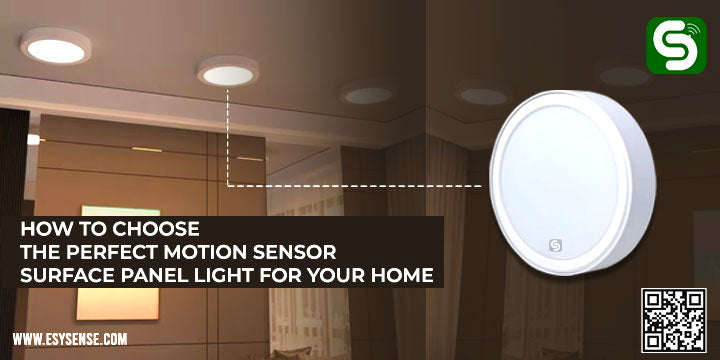
How to Choose the Perfect Motion Sensor Surface Panel Light for Your Home
How to Choose the Perfect Motion Sensor Surface Panel Light for Your Home
We've all experienced that moment of fumbling for light switches in the dark or leaving lights on accidentally, driving up our energy bills. These common household frustrations led me to discover motion sensor surface panel lights – a smart lighting solution that's transforming how we illuminate our homes.
A motion sensor surface panel combines advanced detection technology with modern lighting design, offering both convenience and energy efficiency. As we explore these innovative fixtures, we'll help you understand the essential features, installation requirements, and key factors to consider when choosing the perfect motion sensor light for your space.
In this guide, we'll walk through everything you need to know about selecting the right motion sensor surface panel light, from basic functionality to advanced features that make these lights a valuable addition to any home.
Understanding Motion Sensor Panel Light Basics
Let's dive into how motion sensor surface panels actually work. These innovative lighting solutions combine two crucial elements: detection technology and efficient illumination.
At the heart of every motion sensor surface panel are sophisticated detection systems. The most common types we encounter are:
- Passive Infrared (PIR): These sensors detect body heat and are highly efficient, using minimal power while providing reliable detection
- Microwave Sensors: These emit microwave signals to detect movement, offering consistent performance regardless of temperature
We find that PIR sensors are particularly effective for indoor spaces, as they excel at detecting motion in confined areas like corridors and walkways. They work by measuring changes in infrared radiation when someone enters their detection zone, making them incredibly energy-efficient.
For larger spaces, we often recommend microwave sensor panels. These can cover more extensive areas and even detect movement through non-metallic obstacles. However, it's worth noting that they might be more sensitive to environmental factors like moving branches or leaves.
Essential Features to Consider
When selecting a motion sensor surface panel for our homes, we need to focus on several crucial features that will ensure optimal performance. Let's explore what makes these smart lighting solutions truly effective.
First, we should consider the detection capabilities. Most standard sensors can detect motion at distances of about 4.6 meters (15 feet), though some advanced models offer detection ranges up to 8 meters with a 150-degree detection angle.
Smart Integration Features We've found that modern motion sensor panels offer impressive smart home capabilities. They can:
- Connect with security cameras and alarm systems
- Send instant smartphone notifications
- Integrate with other smart home devices
- Allow remote control and monitoring
Another critical aspect is the lighting performance. Quality panels typically deliver around 100 lumens per watt, providing ample illumination for any space. For enhanced functionality, look for panels with multiple operating modes. The best ones offer three intelligent settings: constant-on, off, and auto-sensing modes.
Practical Considerations We should also consider the panel's energy management features. Most models automatically power off within 60 seconds when no movement is detected, and some advanced versions include ambient light sensing to prevent activation during daylight hours. For durability, we recommend choosing panels with surge protection - some models can withstand fluctuations up to 4KV.
When it comes to customization, modern panels allow us to adjust sensitivity levels and timing settings. This flexibility ensures the light activates only when needed and stays on for an appropriate duration. For outdoor installations, we should look for models with adequate IP ratings to ensure weather resistance.
Installation and Placement Guidelines
Proper installation of our motion sensor surface panel can make the difference between optimal performance and frequent adjustments. We've found that the ideal mounting height ranges between 6 to 10 feet from the ground, striking the perfect balance between detection accuracy and coverage area.
For installation type, we have two main options. While wireless sensors offer easier installation and flexibility, hardwired systems provide superior reliability. If we're considering DIY installation, wireless sensors are our best bet, but for hardwired systems, we strongly recommend professional installation, especially if we lack electrical expertise.
When it comes to strategic placement, we should consider these key locations:
- Entry Points: Doors and garage entrances for maximum security
- Pathways: Along walkways and staircases for safe navigation
- High-Traffic Areas: Areas where movement is frequent
- Corners: For the widest possible coverage area
For optimal performance, we need to avoid certain placement mistakes. Keep our motion sensor surface panel away from:
- Heat sources like vents or radiators
- Direct sunlight exposure
- Large furniture that could create blind spots
If we're opting for professional installation, expect costs between INR 4,219 to INR 12,657 per hour. However, this investment often pays off through proper setup and reliable performance. For DIY installation, we'll need basic tools including a screwdriver, wire stripper, wire connectors, and electrical tape.
Remember to test the sensor's coverage area after installation by walking through the space at different angles. This helps ensure we've achieved the optimal detection zone for our specific needs.
Conclusion
Motion sensor surface panel lights offer a smart solution to our everyday lighting needs. Through our exploration of these innovative fixtures, we've seen how different sensor technologies, smart features, and proper installation work together to create an efficient lighting system.
PIR sensors excel in indoor spaces, while microwave sensors handle larger areas effectively. Smart integration capabilities and customizable settings make these panels adaptable to various situations. Most importantly, their energy-saving features help reduce our electricity bills while maintaining optimal illumination.
Successful implementation depends on careful consideration of mounting height, placement strategy, and environmental factors. Whether we choose professional installation or DIY setup, following proper guidelines ensures reliable performance and maximum coverage.
These lighting solutions prove that practical home improvements don't need to be complicated. With the right motion sensor surface panel light, we can create a more comfortable, efficient, and secure living space that responds to our needs automatically.
